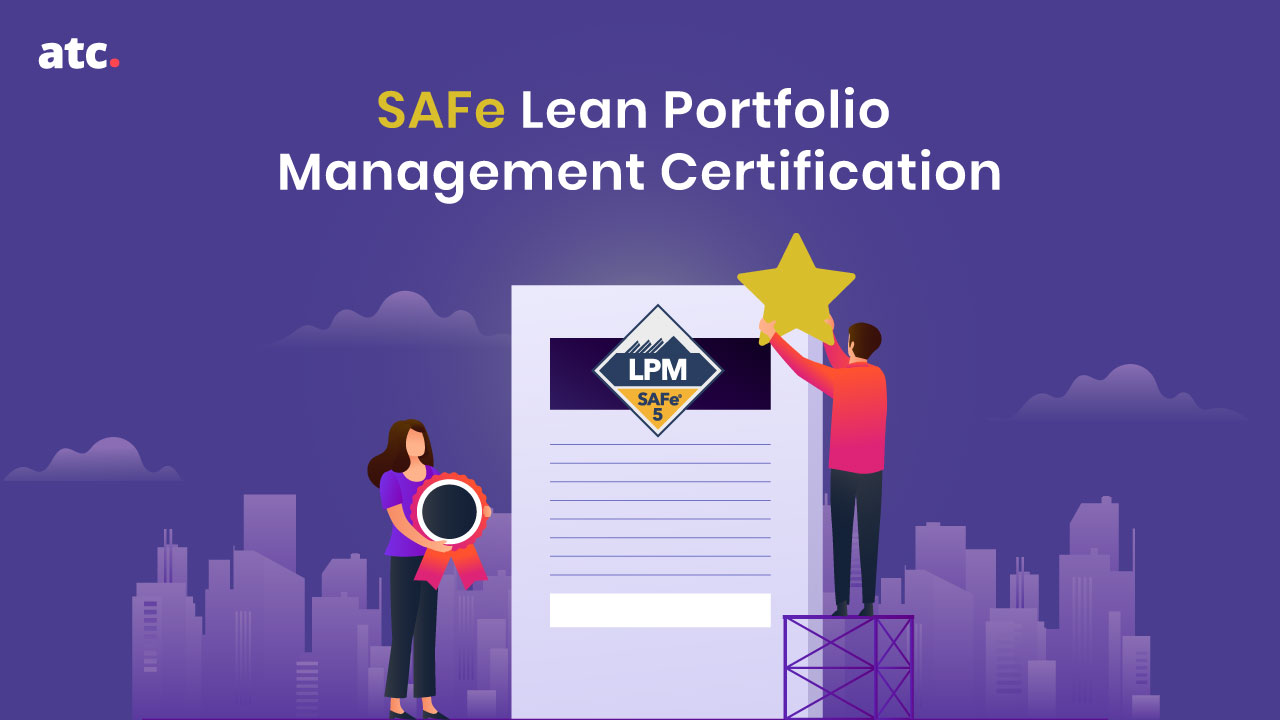Subscribe to the blog
Having a collaborative project development approach is fundamental for an organization’s health, direction, and impact. And this is why Scaled Agile Framework has gained so much prominence recently. SAFe calls for better collaboration and alignment between Agile teams to deliver faster product updates. It also pinpoints flaws and creates better opportunities for workflow improvement.
However, investment planning and gaining end-to-end visibility are still challenging for most SAFe organizations.
This is where Lean Portfolio management comes in.
This article will discuss the objectives of Lean Portfolio Management, what you will gain from the certification, and how it will impact your career.
What is the primary focus of Lean Portfolio Management (LMP)?
Even after the implementation of Agility, organizations suffer from increased development costs and a lack of cross-team visibility. One of the ways to resolve this problem is to apply lean principles to link Agile development with business strategy.
Lean Portfolio Management talks in-depth about increasing the organization’s ability to plan, and execute its development initiatives, enabling them to deliver product updates faster and improve business outcomes. It helps companies prioritize high-value work first and look for areas with the most opportunity.
Here are the three essential objectives of Lean Portfolio Management:
- Maximize value output: The framework aims to manage the backlog of investments and analyze the work-in-process of projects across teams to enhance project delivery.
- Prevent bottlenecks: Using portfolio budgets, you can balance the funding capacity with demand to leverage high-value opportunities.
- Establish good servant leadership: LPM tools and guidelines can help organizations facilitate better collaboration to keep delivery cycle times low.
So how does this happen? To understand that, let’s review the three dimensions of Lean Portfolio Management:
- Strategy and investment funding
This dimension tells companies to invest in work with the highest value. It includes creating a portfolio with a detailed task list that meets business value and ROI, ensuring that organizations develop solutions that customers need and successfully drive the costs down.
It requires business executives, portfolio stakeholders, and project managers to collaborate and execute the following responsibilities:
- Connect the portfolio to enterprise strategy
- Maintain a portfolio vision
- Realize portfolio vision through epics
- Establish Lean budgets and guardrails
- Establish portfolio flow
- Agile portfolio operations
Here, the organization creates guardrails for funding processes and policies. It includes organizing quarterly meetings to ensure that all high-value priorities are well-funded so there is maximum value realization.
Let’s review what Agile portfolio operations involve:
- Coordinating value streams
- Support program execution
- Foster operational excellence
- Lean governance
It helps SAFe organizations manage spending, audit, compliance, and forecasting expenses. It involves all portfolio stakeholders actively engaging in:
- Forecasting and budgeting dynamically
- Measuring portfolio performance
- Coordinating continuous compliance
Doing this helps value stream leaders use their capacity and budget to optimize and achieve deliverables.
How is LPM different from other project portfolio frameworks?
There has been a heated discussion on how LPM differs from other project portfolio frameworks. While most frameworks focus on defining the desired quantity of outputs, LPM is more concerned with quality outcomes. For better clarity, let’s do a quick comparison:
| Scope | Traditional Portfolio Management Framework | Lean Portfolio Management |
| Project deliverables | The work is assigned to the team by those in leadership positions. | Agile teams define work. |
| Budgeting | Top-down approach towards budgeting. Portfolio managers decide and allocate the budget. | Using participatory budgeting where stakeholders collaborate and build consensus to allocate portfolio budget to individual value streams. |
| Performance review | Annual review of budgets and finances based on the completion of tasks. | Quarterly review of budget and finances based on delivery of customer value. |
| Elimination of bottlenecks | Limited as information sharing is restricted | Work-in-progress is continually forecasted, monitored, and adjusted. Participatory discussions increase information-sharing between leaders and cross-functional teams. |
How can Lean Portfolio Management Certification supercharge your career?
Let’s review how acquiring a Lean Portfolio Certification can accelerate career growth:
Take your SAFe knowledge to the next level
If you are a SAFe professional who wants to reach a leadership position, getting LPM certified can unlock better career opportunities.
With a SAFe LPM approach, you can collaborate across silos, empower teams, and organize around value. This showcases your leadership skills and helps you become an asset in the workplace. You can demonstrate your knowledge and manage multiple portfolios, enabling employers to take notice of your work.
Studies show that 74% of employees feel they aren’t reaching their full potential at work. Enhancing your skillset can help you thrive in an Agile environment and tackle bottlenecks.
LPM professionals earn high salaries
According to recent reports, LPM managers can earn up to $167,326 per year. Also, salaries for experienced professionals can even go higher. So if you are stuck in a career rut, Lean Portfolio Management certification is the best way to move forward.
Key elements of Lean Portfolio Management Certification
This certification aims to help Project Managers, Agile Coaches, Release Train Engineers, and other professionals to develop an in-depth understanding of the framework and get equipped with tools and techniques to implement LPM functions.
Top 3 things you will learn from an LPM certification:
- Define LPM functions and use in-demand tools for better value maximization
- Align strategic portfolio execution with business outcomes
- Build a plan for LPM implementation, coordinate value streams, and measure LPM performance
Steps you need to follow to gain the certification:
Securing Lean Portfolio Management Certification requires you to follow three essential steps. Let’s discuss them below:
- Enroll in a training program
The first thing is getting yourself enrolled in a reputed LPM training program. It will help you gain a fundamental understanding of the framework. Getting familiar with complex concepts and gathering insights about tools, techniques, and industry practices from experts can help you develop a skillset to implement Lean-Agile Portfolio Management with ease.
Also, SAFe requires attendees to compulsorily take a 16-hour training from an authorized training partner to take the examination.
- Prepare for the examination
After completing your 16-hour training program, you will receive the credentials directly from Scaled Agile along with the information you need to ace your SAFe Lean Portfolio Management exam.
You can log in and study the examination details, including the exam format, duration, and retake policy. You can seek the help of your training partner to ensure that you don’t miss out on details.
- Keep refreshing your knowledge and connect with the SAFe community
Gaining your Lean Portfolio Management certification unlocks opportunities to connect with the growing community of SAFe practitioners. After securing your certification, you can keep refreshing your knowledge by developing professional relationships with fellow practitioners and reading helpful resources from Scaled Agile.
Aspire for a better career with our immersive LPM training program!
As an authorized partner of Scaled Agile, we offer a Lean Portfolio Management training program that delivers an interactive and engaging learning experience from the most experienced agile trainers worldwide. Our 2-day program provides hands-on experience through various group learning and simulation exercises.
With our LPM training, you will:-
- get trained by the industry’s most experienced trainers
- learn with practical case studies, group activities, and simulations
- explore better career opportunities and expand your leadership skills
- connect and collaborate with global SAFe experts
Register here and get exciting offers that will help you save up to $650.




